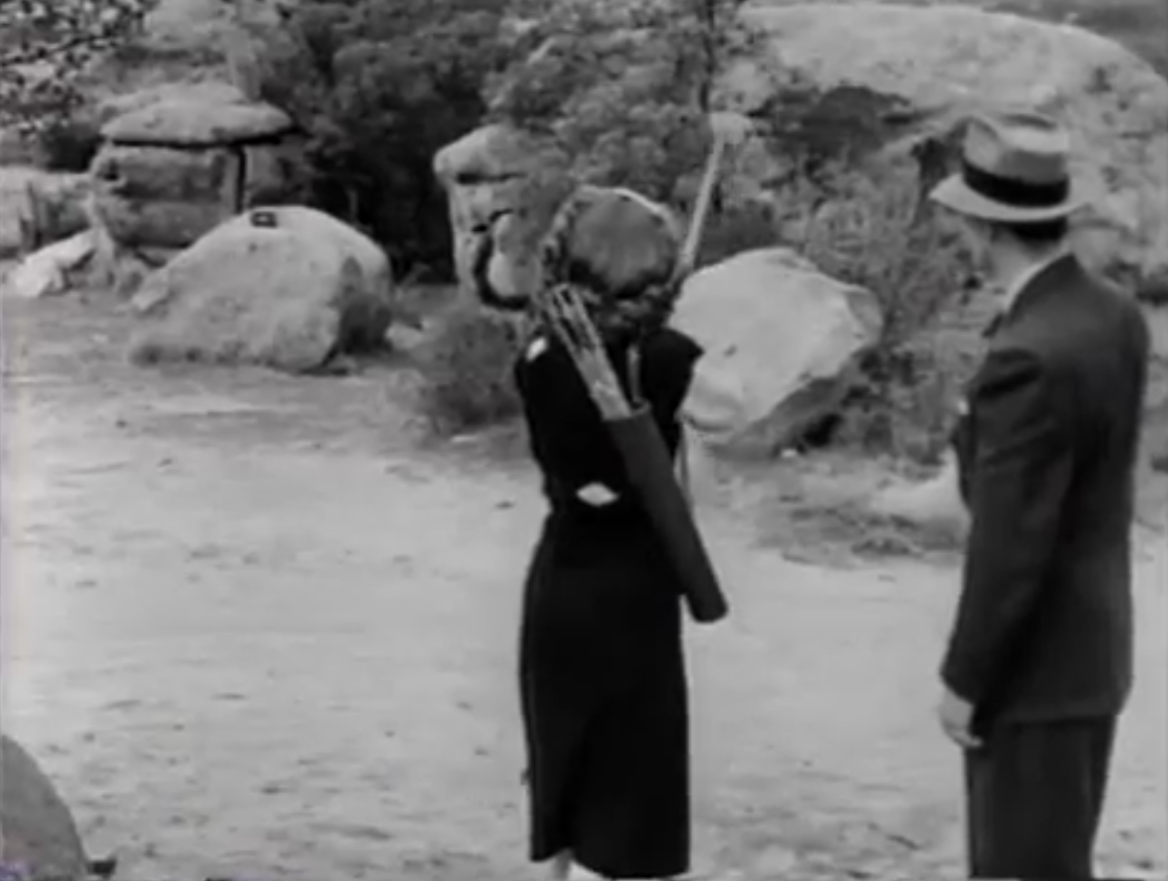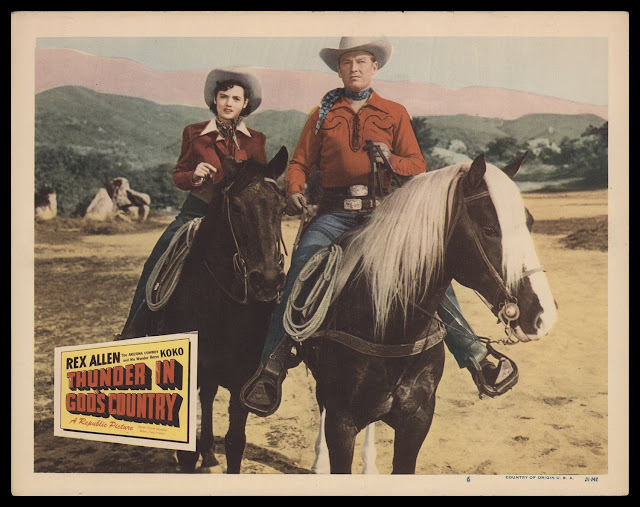Lorna Gray, aka Adrian Booth
As a contract player at Columbia early in her career and later as one of Republic Pictures' top stars, actress Lorna Gray was a regular on the Iverson Movie Ranch.
Lorna Gray with Kirk Alyn on the Lower Iverson in "Daughter of Don Q" (1946)
Gray racked up a string of screen credits, largely in serials and B-Westerns, from the late 1930s through the 1940s before retiring from acting in 1951. Born Virginia Pound, she worked for about a decade as Lorna Gray and then wound down her career under the stage name Adrian Booth.
Gray made a big impact at Iverson as the villainous Vultura in the 1942 Republic serial "Perils of Nyoka," leaving behind an unusual legacy of rocks and other features on the movie ranch that now bear informal "Vultura-related" nicknames: Vultura's Pass, Vultura's Trail, Vultura's Trail Rock, Vultura's Stakeout, etc.
I've posted before about Vultura's Palace, a "Perils of Nyoka" set built on the Lower Iverson. You can click here to see "then and now" shots of the area where the palace stood. The structure was a false front built onto high-profile rocks that remain in place today in a privately owned section of the former movie ranch.
"Daughter of Don Q" (1946): Lorna Gray in the North Cluster, on the Lower Iverson
Gray earned a reputation as an actress who was "good at being bad," and frequently wound up playing evil characters. But her versatile chops enabled her to break out of that mold from time to time, something she did with panache in the 1946 Republic serial "Daughter of Don Q."
Gray segues smoothly into the spotlight as the serial's heroine — and she is an action heroine in the purest sense. Much of the action in "Daughter of Don Q" takes place on the Iverson Movie Ranch.
Jennifer Lawrence as Katniss Everdeen in "The Hunger Games"
Gray's bow-and-arrow-wielding heroine was a forerunner to — and possibly inspiration for — later heroic female archers such as Katniss Everdeen of "The Hunger Games" ...
... and red-haired Merida of Disney/Pixar's 2012 animated feature "Brave."
Kirk Alyn and Lorna Gray in "Daughter of Don Q"
Gray stars with Kirk Alyn, who two years later would become the first Superman of the movies, starring in the 1948 Columbia serial "Superman" and the 1950 sequel "Atom Man vs. Superman."
This shot from behind the actors locks in where the scene takes place — it's just north of Garden of the Gods on the former Iverson Movie Ranch, with the well-known movie landmark Cleft Rock providing a positive ID.
This movie rock is still in place at Iverson, as you'll see below, and you can click here to see a post containing additional photos and other details about Cleft Rock.
In her 20s Lorna Gray was a contract player at Columbia, starring opposite movie cowboy Charles Starrett in 1940 in "Bullets for Rustlers," filmed largely on the Iverson Ranch.
Gray wasn't afraid to mix it up with the boys, and got right in the middle of the action for this shootout among the rocks north of the Garden of the Gods in "Bullets for Rustlers."
"Bullets for Rustlers" (1940)
This shot, another one taken north of Garden of the Gods, contains a number of noteworthy features.
Notice the large rock in front of Lorna Gray, with the major cleft pointed out.
Here's a photo of that same area from a recent visit to Iverson. The rock behind which Lorna Gray stood, with the major cleft, appears again here, on the right.
Monte Hale and Lorna Gray — billed here as Adrian Booth — in 1947
Other movies Lorna Gray — by this time working as Adrian Booth — shot at Iverson included a number of Republic Pictures' Monte Hale titles: "Home on the Range" (1946); "Out California Way" (1946), with Hale, Roy Rogers and a young Robert ("Bobby") Blake; "The Man From Rainbow Valley" (1946); "Under Colorado Skies" (1947); "Last Frontier Uprising" (1947); and "California Firebrand" (1948), to name a few.
Lorna Gray and Don Douglas in "Deadwood Dick"
Gray starred with Don Douglas in Columbia's 1940 serial "Deadwood Dick," another Iverson production, and worked the Iverson Ranch yet again in Republic's "The Gallant Legion" (1948), starring alongside Wild Bill Elliott.
The movies I've mentioned are just a sampling of Gray's Iverson Movie Ranch filmography — of her 69 film credits in the span of a career that lasted just 14 years, it's probably not a stretch to say that most of those movies were filmed on the Iverson Ranch.
Adrian Booth Brian in 2009
Lorna Gray, who later went by Adrian Booth Brian, was still going strong in 2014 when an early version of this blog post first ran. In her later years she still regularly made the rounds of movie conventions and other industry events.


































































